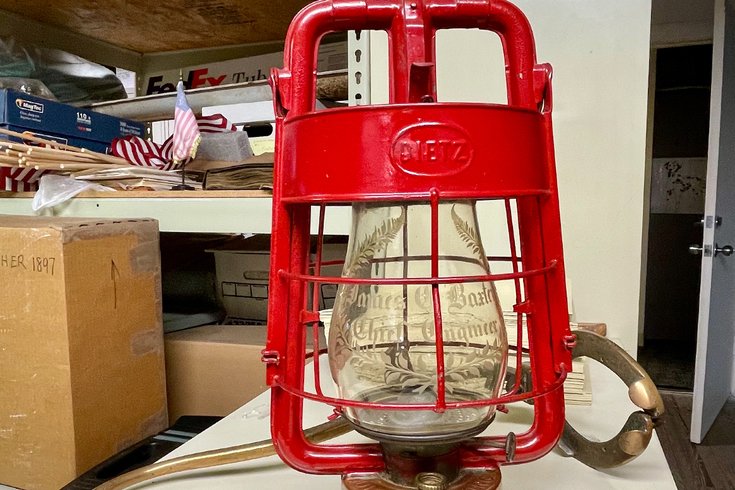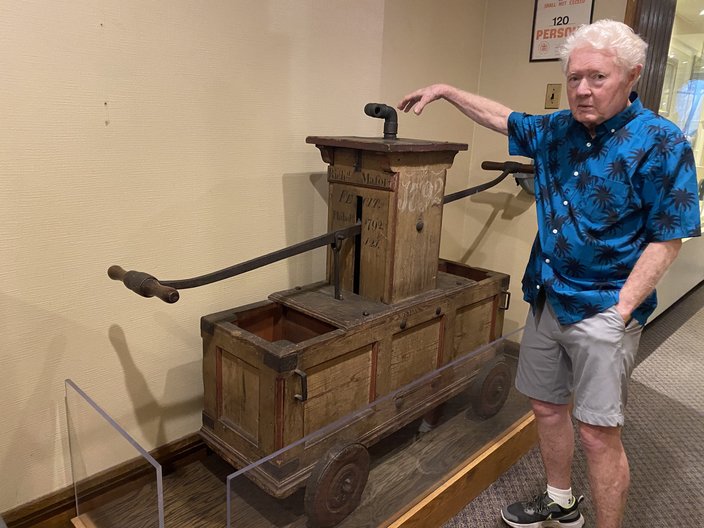
June 17, 2024
 Provided image/Fireman's Hall Museum
Provided image/Fireman's Hall Museum
This lantern from the Fireman's Hall Museum collection belonged to James C. Baxter, the chief engineer of the Philadelphia Fire Department from 1892 to 1911.
When a fire broke out in late 19th century Philadelphia, the word went out through telegraph.
The responding fire company would spring into action, hooking its horses up to the carriage bearing the steam engine — a bulky collection of cranks, tubes and pistons that blasted hundreds of gallons of water a minute. There would be separate carriages for the ladders, and carts for the leather hoses. Leadership would ride in a separate carriage, with a detachable lantern swinging from a hook to illuminate dark spaces.
The Fireman's Hall Museum, a collection of artifacts housed in a historic firehouse at 147 N. Second St. in Old City, still has one of those lanterns. It's a cherry red fixture with an engraved bulb bearing its owner's name: James C. Baxter, chief engineer of the Philadelphia Fire Department from 1892 to 1911. Baxter's half-century of service started during the Civil War, when firefighting was a volunteer position, and ended as automobiles came into the picture, making him the perfect guide through the PFD's early, official history.
Firefighting in Philadelphia stretches back to the city's colonial days, but the work wasn't paid or even part of an organized city department until 1871. Prior to that date, a cluster of volunteer companies put out fires across neighborhoods. According to Lee Ryan, a collections manager for the Fireman's Hall Museum, these men were good at what they did, but petty squabbling over territories and bragging rights often got in the way.
"In the 1830s and 1840s, it got to be very competitive," Ryan explained. "They started getting into fights with each other. And those fights got, in some cases, to a point where guys were shot. And that's why the paid department ended up coming in. The politicians just said, enough's enough. We've been telling you guys you've got to get it together."
The city took the reins at an interesting time. Fire departments across the United States had only recently adopted steam engines, a modern innovation that supplanted the more primitive hand engines, which worked a bit like a seesaw, with firefighters standing on either side of a lever and frantically pumping to expel water. Early mechanical engines also had locked wheels, and could only be transported by slotting planks on either side and picking them up.
Bob Shea shows off a 1792 hand engine from the museum's collection. The handles along the side accommodated planks, which were used to pick up the engine.
Innovations like chemical wagons were also on the horizon. Bob Shea, another collections manager for the museum, described this equipment as essentially a fire extinguisher, but bigger. These copper or brass tanks typically carried 30-40 gallons of soda and acid, which produce a chemical reaction when combined. The solution, which shot out of an attached rubber hose, could be deployed in smaller, controlled situations.
"It's a quick response because, don't forget, otherwise you'd have a boiler on your steam fire engine," Shea explained. "So that boiler had to be able to produce enough pressure to throw the water that you could get from the hydrants. So with the chemical, you would instantly have pressure. And you'd have ability to fight a fire."
Baxter would've been around for chemical wagons, which were in use roughly from the 1880s to the 1930s, though it's not clear how much he used them. One new technology he definitely did use was cars. The city's fire department began slowly transitioning from horse-drawn carriages to motorized trucks in 1913, when the first all-wheel drive gasoline/electric tractors arrived at two fire companies. But automobiles for the fire chief were introduced earlier. Baxter rode in the first one in 1907, proclaiming cars are "the Twentieth Century way of fighting fires."
Ladder 16's 1913 Webb/Couple Gear all-wheel drive, gasoline/electric tractor pulling an 85 ft. tillered aerial ladder with a crew of 12. It was one of the first motorized apparatus in the city. This marked the beginning of the transition from horse-drawn to motorized apparatus. pic.twitter.com/McEGqFXLkP
— Firemans Hall Museum (@FiremansHall) December 11, 2023
Despite all these advancements, firefighting at the turn of the 20th century was extremely dangerous — and not just because of the flames and smoke. The dirt and cobblestone roads were tough on horse-drawn carriages, especially ones ferrying such heavy equipment, making traffic accidents common. Buildings were also more flammable, since fireproofing was still a relatively new construction concept. The steam fire engines could explode without careful maintenance.
"Trolley tracks were a major issue," Ryan added. "If the wheel is caught in the trolley tracks, it could flip the carriage or engine, for that matter."
Baxter was thrown from his carriage multiple times, buried by collapsing walls and struck by falling debris. His Inquirer obituary stated he was hospitalized 21 times for injuries on the job and was bedridden for the last six months of his life due to sustained harm to his legs.
This disregard for his own personal safety was unsurprising to people who knew him. By all accounts, Baxter was an extraordinarily devoted public servant who, according to a 1965 PFD newsletter, only got married because he fell in love with the woman living next door to the firehouse. But as Ryan, who recently retired from active service in Camden, can attest, it still takes a certain amount of commitment — and maybe a touch of lunacy — to do the job in 2024.
"People say we're nuts," he said. "Maybe we are. But somebody's gotta do it."
Follow Kristin & PhillyVoice on Twitter: @kristin_hunt
| @thePhillyVoice
Like us on Facebook: PhillyVoice
Have a news tip? Let us know.
 Kristin Hunt/for PhillyVoice
Kristin Hunt/for PhillyVoice